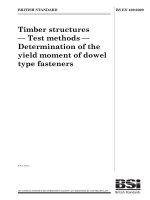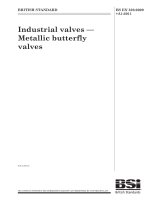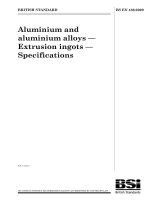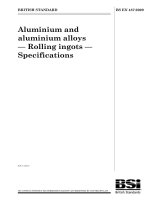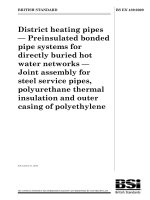Bsi bs en 62267 2009
Bạn đang xem bản rút gọn của tài liệu. Xem và tải ngay bản đầy đủ của tài liệu tại đây (1.48 MB, 66 trang )
Licensed Copy: athen reading, Reading University Library, 23/01/2010 04:58, Uncontrolled Copy, (c) BSI
BS EN 62267:2009
BSI Standards Publication
Railway applications —
Automated urban guided
transport (AUGT) — Safety
requirements
NO COPYING WITHOUT BSI PERMISSION EXCEPT AS PERMITTED BY COPYRIGHT LAW
raising standards worldwide™
BRITISH STANDARD
Licensed Copy: athen reading, Reading University Library, 23/01/2010 04:58, Uncontrolled Copy, (c) BSI
BS EN 62267:2009
National foreword
This British Standard is the UK implementation of EN 62267:2009. It is
identical to IEC 62267:2009. It supersedes DD IEC/PAS 62267:2005 which is
withdrawn.
The UK participation in its preparation was entrusted to Technical Committee
GEL/9, Railway Electrotechnical Applications.
A list of organizations represented on this committee can be obtained on
request to its secretary.
This publication does not purport to include all the necessary provisions of a
contract. Users are responsible for its correct application.
© BSI 2010
ISBN 978 0 580 63238 9
ICS 03.220.30; 45.060.01
Compliance with a British Standard cannot confer immunity from
legal obligations.
This British Standard was published under the authority of the Standards
Policy and Strategy Committee on 31 January 2010
Amendments issued since publication
Amd. No.
Date
标准分享网 www.bzfxw.com 免费下载
Text affected
Licensed Copy: athen reading, Reading University Library, 23/01/2010 04:58, Uncontrolled Copy, (c) BSI
BS EN 62267:2009
EUROPEAN STANDARD
EN 62267
NORME EUROPÉENNE
EUROPÄISCHE NORM
December 2009
ICS 45.060
English version
Railway applications Automated urban guided transport (AUGT) Safety requirements
(IEC 62267:2009)
Applications ferroviaires Transports guidés
urbains automatiques (AUGT) Exigences de sécurité
(CEI 62267:2009)
Bahnanwendungen - Automatischer
städtischer schienengebundener
Personennahverkehr (AUGT) Sicherheitsanforderungen
(IEC 62267:2009)
www.bzfxw.com
This European Standard was approved by CENELEC on 2009-10-01. CENELEC members are bound to comply
with the CEN/CENELEC Internal Regulations which stipulate the conditions for giving this European Standard
the status of a national standard without any alteration.
Up-to-date lists and bibliographical references concerning such national standards may be obtained on
application to the Central Secretariat or to any CENELEC member.
This European Standard exists in three official versions (English, French, German). A version in any other
language made by translation under the responsibility of a CENELEC member into its own language and notified
to the Central Secretariat has the same status as the official versions.
CENELEC members are the national electrotechnical committees of Austria, Belgium, Bulgaria, Cyprus, the
Czech Republic, Denmark, Estonia, Finland, France, Germany, Greece, Hungary, Iceland, Ireland, Italy, Latvia,
Lithuania, Luxembourg, Malta, the Netherlands, Norway, Poland, Portugal, Romania, Slovakia, Slovenia, Spain,
Sweden, Switzerland and the United Kingdom.
CENELEC
European Committee for Electrotechnical Standardization
Comité Européen de Normalisation Electrotechnique
Europäisches Komitee für Elektrotechnische Normung
Central Secretariat: Avenue Marnix 17, B - 1000 Brussels
© 2009 CENELEC -
All rights of exploitation in any form and by any means reserved worldwide for CENELEC members.
Ref. No. EN 62267:2009 E
Licensed Copy: athen reading, Reading University Library, 23/01/2010 04:58, Uncontrolled Copy, (c) BSI
BS EN 62267:2009
EN 62267:2009
-2-
Foreword
The text of document 9/1261/FDIS, future edition 1 of IEC 62267, prepared by IEC TC 9, Electrical
equipment and systems for railways, was submitted to the IEC-CENELEC parallel vote and was approved
by CENELEC as EN 62267 on 2009-10-01.
The following dates were fixed:
– latest date by which the EN has to be implemented
at national level by publication of an identical
national standard or by endorsement
(dop)
2010-07-01
– latest date by which the national standards conflicting
with the EN have to be withdrawn
(dow)
2012-10-01
Annex ZA has been added by CENELEC.
__________
Endorsement notice
The text of the International Standard IEC 62267:2009 was approved by CENELEC as a European
Standard without any modification.
In the official version, for Bibliography, the following notes have to be added for the standards indicated:
IEC 61508
NOTE Harmonized in EN 61508 series (not modified).
IEC 62128-1
NOTE Identical to EN 50122-1:1997.
IEC 62236
NOTE In Europe, the series EN 50121 applies.
IEC 62279
NOTE In Europe, EN 50128 applies.
www.bzfxw.com
__________
标准分享网 www.bzfxw.com 免费下载
Licensed Copy: athen reading, Reading University Library, 23/01/2010 04:58, Uncontrolled Copy, (c) BSI
BS EN 62267:2009
-3-
EN 62267:2009
Annex ZA
(normative)
Normative references to international publications
with their corresponding European publications
The following referenced documents are indispensable for the application of this document. For dated
references, only the edition cited applies. For undated references, the latest edition of the referenced
document (including any amendments) applies.
NOTE 1 When an international publication has been modified by common modifications, indicated by (mod), the relevant EN/HD
applies.
NOTE 2 Where a standard cited below belongs to the EN 50000 series, this European Standard applies instead of the relevant
International Standard.
Publication
Year
Title
EN/HD
Year
IEC 62278
2002
Railway applications - Specification and
demonstration of reliability, availability,
maintainability and safety (RAMS)
EN 50126-1
+ corr. May
1999
2006
IEC 62290-1
-
1)
Railway applications - Urban guided transport EN 62290-1
management and command/control systems Part 1: System principles and fundamental
concepts
2006
2)
IEC 62425
-
1)
Railway applications - Communication,
signalling and processing systems - Safety
related electronic systems for signalling
2003
2)
EN 50129
www.bzfxw.com
1)
Undated reference.
2)
Valid edition at date of issue.
Licensed Copy: athen reading, Reading University Library, 23/01/2010 04:58, Uncontrolled Copy, (c) BSI
BS EN 62267:2009
–2–
62267 © IEC:2009
CONTENTS
INTRODUCTION.....................................................................................................................7
1
Scope ...............................................................................................................................8
2
Normative references ..................................................................................................... 10
3
Terms, definitions and abbreviations .............................................................................. 10
4
3.1 Terms and definitions ............................................................................................ 11
3.2 Abbreviations ........................................................................................................ 13
Methodology................................................................................................................... 13
5
4.1 System definition and application conditions ......................................................... 14
4.2 Hazard analysis at top system level....................................................................... 14
4.3 Safety requirements .............................................................................................. 14
System description ......................................................................................................... 14
6
5.1 Station .................................................................................................................. 15
5.2 Train ..................................................................................................................... 15
5.3 Guideway between stations ................................................................................... 16
5.4 System boundaries ................................................................................................ 17
Entities to be protected................................................................................................... 18
6.1
7
Persons ................................................................................................................. 18
6.1.1 Passengers ............................................................................................... 18
6.1.2 Staff .......................................................................................................... 18
6.1.3 External emergency services ..................................................................... 19
6.1.4 Public ........................................................................................................ 19
6.2 Property ................................................................................................................ 19
Identified hazardous situations and possible safeguards ................................................ 19
www.bzfxw.com
7.1
8
Supervising guideway............................................................................................ 20
7.1.1 Prevent collisions with obstacles ............................................................... 20
7.1.2 Prevent collisions with persons .................................................................. 21
7.2 Supervising passenger transfer ............................................................................. 23
7.2.1 Control passenger doors ........................................................................... 23
7.2.2 Prevent injuries to persons between cars or between platform and
train........................................................................................................... 23
7.2.3 Ensure safe starting conditions .................................................................. 24
7.3 Operating a train ................................................................................................... 25
7.3.1 Put in or take out of operation.................................................................... 25
7.3.2 Supervise the status of the train ................................................................ 26
7.4 Ensuring detection and management of emergency situations ............................... 27
Safety requirements ....................................................................................................... 30
8.1
8.2
General requirements ............................................................................................ 30
8.1.1 Public works regulations to protect the guideway ....................................... 30
8.1.2 Fire protection ........................................................................................... 31
8.1.3 Systems and equipment ............................................................................ 31
8.1.4 Rules for passenger behaviour .................................................................. 32
Monitoring the AUGT system ................................................................................. 32
8.2.1 Monitoring by the OCC staff ...................................................................... 32
8.2.2 Action of operational staff .......................................................................... 33
8.2.3 Communication systems ............................................................................ 33
标准分享网 www.bzfxw.com 免费下载
Licensed Copy: athen reading, Reading University Library, 23/01/2010 04:58, Uncontrolled Copy, (c) BSI
BS EN 62267:2009
62267 © IEC:2009
8.3
8.4
8.5
–3–
Operational rules ................................................................................................... 34
8.3.1 Rules for rescue of passengers ................................................................. 34
8.3.2 Rules for fire emergency............................................................................ 34
8.3.3 Rules for foreseeable vandalism ................................................................ 35
8.3.4 Rules for checking guideway clearance ..................................................... 35
8.3.5 Rules for start-up and shut down of operations .......................................... 35
8.3.6 Rules for train operations in the depot ....................................................... 36
8.3.7 Rules for trains to be put in or taken out of operation................................. 36
8.3.8 Rules for stranded train removal ................................................................ 36
Safeguards on platforms ....................................................................................... 36
8.4.1 Common safeguards for enclosed and open platforms ............................... 37
8.4.2 Enclosed platforms .................................................................................... 39
8.4.3 Open platforms with detection systems ...................................................... 41
Safeguards in trains .............................................................................................. 41
8.5.1 Door closed supervision ............................................................................ 42
8.5.2 Door release for passenger transfer .......................................................... 42
8.5.3 Door release for emergency opening ......................................................... 43
8.5.4 Emergency exits ........................................................................................ 43
8.5.5 On board obstacle detection device ........................................................... 43
8.5.6 Derailment detection device ...................................................................... 43
8.5.7 On board video surveillance ...................................................................... 44
8.5.8 Public address system (train) .................................................................... 44
8.5.9 On board announcement for taking a train out of operation ........................ 44
8.5.10 Emergency stop demand on board ............................................................ 44
8.5.11 Emergency call device on board ................................................................ 45
8.5.12 Fire and smoke detection (train) ................................................................ 45
8.5.13 Train status supervision and testing........................................................... 45
8.5.14 Manual operation ....................................................................................... 46
8.5.15 Safe speed during automatic coupling ....................................................... 46
8.5.16 Reaction to unexpected train movement .................................................... 46
8.5.17 Warning means in the train for evacuation ................................................. 46
Safeguards for passenger transfer area................................................................. 46
8.6.1 Train immobilisation during passenger transfer .......................................... 47
8.6.2 Safeguards related to the opening of the doors.......................................... 47
8.6.3 Safeguards related to the closing of the doors ........................................... 47
8.6.4 Marking of train door areas on the platform ............................................... 48
8.6.5 Surveillance by operational staff ................................................................ 49
8.6.6 Safeguards related to gap between train and platform ............................... 49
8.6.7 Safeguards related to coupling area between cars..................................... 51
8.6.8 Safeguards related to space between train and platform screen ................ 51
8.6.9 Safeguards to protect passengers from electrocution after falling into
the gap ...................................................................................................... 51
Safeguards for guideway ....................................................................................... 51
8.7.1 Segregated guideway ................................................................................ 52
8.7.2 Warning means along the guideway .......................................................... 52
8.7.3 Physical barriers along the track ................................................................ 52
8.7.4 Physical barriers beside bridges ................................................................ 52
8.7.5 Intrusion detection device between platform track and guideway
between stations ....................................................................................... 52
www.bzfxw.com
8.6
8.7
Licensed Copy: athen reading, Reading University Library, 23/01/2010 04:58, Uncontrolled Copy, (c) BSI
BS EN 62267:2009
–4–
9
62267 © IEC:2009
8.7.6 Guideway intrusion detection device .......................................................... 53
8.7.7 Wayside obstacle detection device ............................................................ 53
8.7.8 Platform end door with controlled access ................................................... 53
8.7.9 Emergency exit from physically segregated guideway................................ 53
8.7.10 Fire and smoke detection (guideway between stations) ............................. 53
8.7.11 Water flooding protection........................................................................... 54
8.7.12 Level crossing ........................................................................................... 54
8.7.13 Work zones ............................................................................................... 55
8.8 Safeguards for transfer areas and depots .............................................................. 55
Information for use ......................................................................................................... 56
10 Specific safety requirements for upgrading existing lines to DTO or UTO ....................... 56
11 Verification of safety ....................................................................................................... 57
11.1 Documentation and responsibilities ....................................................................... 58
11.2 Verification process ............................................................................................... 58
Annex A (informative) Role of the OCC ................................................................................ 60
Bibliography.......................................................................................................................... 61
Figure 1 – Life Cycle Phases covered by this standard (see Figure 10 of IEC 62278) ........... 13
Figure 2 – Boundary of the station subsystem....................................................................... 15
Figure 3 – Boundary of the “guideway between stations” subsystem ..................................... 16
Figure 4 – Boundary of the “guideway between stations” subsystem with level crossing ....... 17
www.bzfxw.com
Figure 5 – Boundary of the “guideway between stations” subsystem with sidings .................. 17
Figure 6 – Verification of safety ............................................................................................ 58
Figure A.1 – Role of the OCC in the safety of the system...................................................... 60
Table 1 – Grades of automation ..............................................................................................9
Table 2 – Prevent collisions with obstacles ........................................................................... 20
Table 3 – Prevent collisions with persons ............................................................................. 21
Table 4 – Prevent injuries to persons associated with opening and closing passenger
transfer doors ....................................................................................................................... 23
Table 5 – Prevent injuries to persons between cars or between platform and train ................ 24
Table 6 – Prevent passenger injury during train starting........................................................ 25
Table 7 – Prevent harm to passengers in relation to taking the train out of operation or
putting the train in operation ................................................................................................. 26
Table 8 – Prevent injury to person resulting from train failures .............................................. 26
Table 9 – Prevent injury to persons related to emergency situations ..................................... 27
标准分享网 www.bzfxw.com 免费下载
Licensed Copy: athen reading, Reading University Library, 23/01/2010 04:58, Uncontrolled Copy, (c) BSI
BS EN 62267:2009
62267 © IEC:2009
–7–
INTRODUCTION
This International Standard is a generic guideline providing recommendations to assist railway
authorities and safety regulatory authorities to define safety requirements appropriate to
AUGT systems. The generic requirements recommended in this standard are based on the
experience gained from AUGT systems already in operation. Safety requirements for each
specific application, however, can only be defined from the results of a risk analysis, taking
into consideration the conditions in which the AUGT system is to be set up and based on the
risk acceptance principles prevailing in the local environment. The standard applicable for
conducting a mandatory and comprehensive risk analysis of an AUGT system is IEC 62278
(RAMS).
In view of the diversity of the technical solutions that may be adopted for new AUGT systems
and the diversity of operational conditions, the list of generic hazardous situations considered
in this standard should be regarded as a minimum list. The requirements for a safeguard as
described in this standard are intended as minimum requirements in case a specific safeguard
is applied to mitigate the related hazardous situation. However, the specific risk analysis may
show that some requirements of a chosen safeguard should be modified to take into account
some specific conditions. Each specific design of the new AUGT system and each aspect of
the specific topographic, environmental, social or legal environment of the new AUGT system
can also generate new hazards and therefore may require additional safety requirements. A
specific hazard analysis to identify additional requirements or requirements to be modified is
therefore always a necessity.
This standard, therefore, does not and could not prescribe any specific means that could,
without a fail, mitigate risks arising from hazardous situations. Rather, it identifies a list of
foreseeable hazardous situations, derived from the elementary consideration that functions
assumed by the driver and staff in conventional systems are replaced in AUGT systems by
automated functions or other safeguards. It is the purpose of this standard that this list of
hazardous situations should be carefully considered during the risk analysis carried out for
any new AUGT system.
www.bzfxw.com
In addition to generic hazardous situations, this standard also describes possible and widely
implemented safeguards that the specific risk analysis may well show to be adapted to the
specific application.
It should be noted that not all hazardous situations identified in the context of one or other of
the large number of different AUGT systems already in operation in the world have
necessarily been covered in this standard. Nor would it have been necessarily helpful. Neither
could this standard describe all the possible safeguards demanded by each and every specific
application.
This standard does not require that a safeguard be put in place for every generic hazardous
situation identified. This is because often, the risk associated with a hazardous situation may
be assessed as tolerable without the need for a safeguard. According to IEC 62278, it is the
responsibility of the railway authority, in agreement with the Safety Regulatory Authority
having jurisdiction, to decide on the tolerability of each risk and on the necessity of a specific
safeguard, taking into account their specific risk acceptance criteria and legal requirements
that are applicable for the specific AUGT application.
Licensed Copy: athen reading, Reading University Library, 23/01/2010 04:58, Uncontrolled Copy, (c) BSI
BS EN 62267:2009
–8–
62267 © IEC:2009
RAILWAY APPLICATIONS –
AUTOMATED URBAN GUIDED TRANSPORT (AUGT) –
SAFETY REQUIREMENTS
1
Scope
This International Standard covers high-level safety requirements applicable to automated
urban guided transport systems, with driverless or unattended self-propelled trains, operating
on an exclusive guideway.
This standard only deals with the safety requirements needed to compensate for the absence
of a driver or attendant staff who would otherwise be responsible for some or all of train
operation functions (see Table 1), depending on the level of automation of the system (see
shaded areas in Table 1 and see 3.1 for a definition of the different grades of automation).
The requirements of this standard are restricted to transports systems as defined in Clause 5
and to DTO and UTO as defined in 3.1.4 and 3.1.20, respectively (see the shaded areas in
Table 1).
www.bzfxw.com
标准分享网 www.bzfxw.com 免费下载
Licensed Copy: athen reading, Reading University Library, 23/01/2010 04:58, Uncontrolled Copy, (c) BSI
BS EN 62267:2009
62267 © IEC:2009
–9–
Table 1 – Grades of automation
On-sight
train
operation
Nonautomated
train
operation
Semiautomated
train
operation
Driverless
train
operation
Unattended
train
operation
TOS
NTO
STO
DTO
UTO
GOA0
GOA1
GOA2
GOA3
GOA4
X
(points
command/
control in
system)
S
S
S
S
X
S
S
S
S
Ensure safe speed
X
X
(partly
supervised
by system)
S
S
S
Control acceleration
and braking
X
X
S
S
S
Prevent collision with obstacles
X
X
X
S
S
Prevent collision with persons
X
X
X
S
S
Control passengers doors
X
X
X
X or S
S
Prevent injuries to persons
between cars or between
platform and train
X
X
X
X or S
S
Ensure safe starting conditions
X
X
X
X or S
S
Put in or take out of operation
X
X
X
X
S
Supervise the status
of the train
X
X
X
X
S
Perform train diagnostic, detect
fire/smoke and detect
derailment, handle emergency
situations (call/evacuation,
supervision)
X
X
X
X
S and/or
staff in OCC
Basic functions of train operation
Ensure safe route
Ensuring safe
movement of
trains
Driving
Supervising
guideway
Supervising
passenger
transfer
Operating a
train
Ensuring
detection and
management
of emergency
situations
Ensure safe separation
of trains
www.bzfxw.com
NOTE
X = responsibility of operations staff (may be realised by technical system).
S = realised by technical system.
This standard does not specifically look at security issues. However, aspects of safety
requirements may apply to assuring security within the transport system.
NOTE
The definitions of “security” and “safety” are given by IEC 62278.
Application of this standard is subsidiary to the responsibility of the transport authority and the
safety regulatory authority (see IEC 62278) and to the specific laws and decrees applicable
within the prevailing environment (economic, social, political, etc.) where the transport system
is located, taking into account:
•
social risk acceptance in different cultures or different national legal regulations (e.g.
SHOREI, BOStrab) or principles (e.g. GAME, ALARP);
•
laws and decrees in different states;
•
special or different requirements specified by the safety regulatory authority or by an
independent assessor in charge of the specific application;
Licensed Copy: athen reading, Reading University Library, 23/01/2010 04:58, Uncontrolled Copy, (c) BSI
BS EN 62267:2009
10
ã
62267 â IEC:2009
the responsibility for ”safe operation“ by the transport authority.
This standard does not apply to the following types of transport systems, unless specifically
required by the Transport Authority:
•
APMs (Automated People Movers) operating entirely inside a privileged environment such
as an airport, a commercial centre or a leisure resort;
•
amusement rides and roller-coasters, generally featuring a single station so that
passengers board and alight the system at the same location;
•
intercity and mainline train services, generally operating in a rural environment on part of
their routes;
•
cable-driven systems;
•
systems featuring electronically guided vehicles with optical sensors, magnetic sensors,
or similar devices/systems.
This standard is not concerned with risks arising during works for construction, installation,
modification and dismantling of a system.
This standard is not concerned with pre-existing DTO or UTO systems (see definitions in 3.1)
that were designed before this standard took effect.
In the case of upgrading an existing transport system to a DTO or UTO system, the risks
associated with the existing system are outside the scope of this standard. However, this
standard and the risk analysis process described are relevant for the additional subsystems
and possibly for the transition process itself. Therefore, the application of the standard is at
the discretion of the safety regulatory authority.
www.bzfxw.com
In the case of extending or modifying an existing DTO or UTO system in operation, this
standard applies only if the change is significant as determined by the safety regulatory
authority. However, the risks due to the relationship with the unchanged parts of existing
systems (e.g. rolling stock, traction power supply, signalling and platforms) should be taken
into account.
2
Normative references
The following referenced documents are indispensable for the application of this document.
For dated references, only the edition cited applies. For undated references, the latest edition
of the referenced document (including any amendments) applies.
IEC 62278:2002, Railway applications – Specification and demonstration of reliability,
availability, maintainability and safety (RAMS)
IEC 62290-1, Railway applications – Urban guided transport management
command/control systems – Part 1: System principles and fundamental concepts
and
IEC 62425, Railway applications – Communication, signalling and processing systems –
Safety related electronic systems for signalling
3
Terms, definitions and abbreviations
For the purposes of this document, the following terms, definitions and abbreviations apply.
标准分享网 www.bzfxw.com 免费下载
Licensed Copy: athen reading, Reading University Library, 23/01/2010 04:58, Uncontrolled Copy, (c) BSI
BS EN 62267:2009
62267 © IEC:2009
3.1
– 11 –
Terms and definitions
3.1.1
Automated Urban Guided Transport
AUGT
system featuring driverless or unattended train operation (as defined below) with selfpropelled, guided vehicles, operating on an exclusive guideway
3.1.2
conventional system
system operated in TOS, NTO or STO
3.1.3
doors closed and locked
doors are considered as being in a closed and locked state if they cannot be opened by
passengers
3.1.4
Driverless Train Operation
DTO
train operated with operations staff present on board the train but not accelerating or braking
and not responsible for observing the guideway in front of the train and stopping the train in
case of a hazardous situation. Safe departure of the train from the station, including door
closing, is either the responsibility of operations staff or of the technical system
3.1.5
exclusive guideway
guideway intended to be used only by one transport system without interference with other
types of transport systems
www.bzfxw.com
3.1.6
grade of automation
automation level of train operation resulting from sharing responsibility for given basic
functions of train operation between operations staff and technical system
3.1.7
guideway clearance
pre-defined space around the track defined relatively to the track and such that trains in
motion cannot, while under operating conditions, come into contact with persons or property
fully outside this space
3.1.8
Non-automated Train Operation
NTO
train operation where the driver (i.e., train operator) is in the front cabin of the train observing
the guideway and stopping the train in case of a hazardous situation. Acceleration and
braking are controlled by the driver in conformance with wayside signals or cab-signalling.
The signalling system supervises the activities of the driver. This supervision may be discrete,
semi-continuous or continuous. Safe departure of the train from the station, including door
closing, is the responsibility of the operations staff whether on board the train or on the
station platform
3.1.9
On Sight Train Operation
TOS
train operation where the driver has full responsibility and no technical system is required to
supervise his activities. However, points (switches) and single tracks can be partially
supervised by the system
Licensed Copy: athen reading, Reading University Library, 23/01/2010 04:58, Uncontrolled Copy, (c) BSI
BS EN 62267:2009
– 12 –
62267 © IEC:2009
3.1.10
Operations Control Centre
OCC
centre from which operation of the line or the network is supervised and managed
3.1.11
passenger cabin
part of the train used for carrying passengers
3.1.12
passenger transfer area
area of the platform directly adjacent to the guideway clearance intended for the passage of
passengers during transfer between the platform waiting area and a train
3.1.13
passenger transfer door
train door which provides access for passenger transfer between the passenger cabin and a
station platform; can also be used as an emergency exit in cases of hazardous situations (e.g.
fire, hazardous fumes)
3.1.14
platform track
area of track located in a station in front of the platform (see Figure 2)
3.1.15
platform waiting area
area of platform where passengers wait for approaching trains, separated from the guideway
clearance by the passenger transfer area
www.bzfxw.com
3.1.16
safety space
area beside the guideway clearance where persons can shelter and not be endangered by
moving trains
3.1.17
Semi-automated Train Operation
STO
train operation where operations staff is located in the front cabin of the train observing the
guideway and stopping the train in case of a hazardous situation. Acceleration and braking is
automated and the speed is supervised continuously by the system. Safe departure of the
train from the station is under the responsibility of the operations staff, whether on board the
train or on the station platform
3.1.18
transfer area
area where the transfer of a train between automated and non-automated areas is made
3.1.19
transport authority
entity which is responsible for safe and orderly operation of a transport system
NOTE For safety aspects, the term “transport authority” is equivalent to the term “railway authority” as used in
IEC 62278.
3.1.20
Unattended Train Operation
UTO
train operated without any operations staff on board (all functions are the responsibility of the
technical system)
标准分享网 www.bzfxw.com 免费下载
Licensed Copy: athen reading, Reading University Library, 23/01/2010 04:58, Uncontrolled Copy, (c) BSI
BS EN 62267:2009
62267 © IEC:2009
– 13 –
3.1.21
zero speed status
safety-related information indicating that the speed of the train is below a pre-defined limit
whereby the system considers the train as stopped
3.2
Abbreviations
ALARP
As Low As Reasonably Practicable
AUGT
Automated Urban Guided Transport
DTO
Driverless Train Operation
GAME
Globalement Au Moins Equivalent (French safety principle meaning “globally at
least equivalent”)
GOA
Grade Of Automation
NTO
Non-automated Train Operation
OCC
Operations Control Centre
SRA
Safety Regulatory Authority
STO
Semi-automated Train Operation
TA
Transport Authority
TOS
On-sight Train Operation
UTO
Unattended Train Operation
4
Methodology
www.bzfxw.com
Methodology used for deriving generic safety requirements given in this standard is based on
the principles of life cycle phases described in IEC 62278. Figure 1 below shows the V
representation of system life cycle and highlights the activities of the methodology.
Life cycle of specific
AUGT application
Concept
Generic approach
of IEC 62267
System Definition
and Application
Conditions
System Definition
and Application
Conditions
Operation and
Maintenance
Hazard Analysis at
top system level
Risk Analysis
System
Requirements
Safety
Requirements
Apportionment
of System
Requirements
Performance
Monitoring
Modification
and Retrofit
De-commissioning
and Disposal
System
Acceptance
System Validation,
including Safety
Acceptance and
Commissioning
Design and
Implementation
Installation
Manufacture
IEC
1029/09
Figure 1 – Life cycle phases covered by this standard (see Figure 10 of IEC 62278)
The methodology consists of the following sequence of activities (shown by the shaded areas
in Figure 1):
Licensed Copy: athen reading, Reading University Library, 23/01/2010 04:58, Uncontrolled Copy, (c) BSI
BS EN 62267:2009
– 14 –
•
defining a generic AUGT system and its application conditions;
•
performing a hazard analysis at the top system level;
ã
deriving safety requirements.
62267 â IEC:2009
These activities are briefly described below.
4.1
System definition and application conditions
Clause 5 defines a generic AUGT system, subsystems, their boundaries and application
conditions. The basic functions of train operation considered are those covered under DTO
and UTO only and shown as shaded in Table 1. System definition clarifies application
conditions as a basis for the generic hazard analysis and enables comparability with specific
applications.
4.2
Hazard analysis at top system level
A hazard analysis at top system level has been conducted for the generic system defined in
Clause 5.
In the sense of this standard the hazard analysis comprises:
•
determination of hazardous situations;
•
identification of possible causes for identified hazardous situations;
•
allocation of possible safeguards.
www.bzfxw.com
Hazardous situations considered are those that arise in an AUGT system when there is:
•
no train driver in the front train cabin (i.e. DTO);
•
no operational staff on board trains (i.e. UTO).
4.3
Safety requirements
As result of the hazard analysis at top system level, possible safeguards, which are able to
compensate for the absence of a train driver in the front cabin, or any operational staff on
board the train, have been identified and are listed in Clause 7. For each safeguard listed in
Tables 2 to 9, Clause 8 gives the corresponding safety requirements. Safeguards and
requirements also take into account the consensus of operational experience gained from a
number of automated systems currently in operation.
This standard does not state the choice of safeguards nor the acceptable level of residual risk
which may vary depending on the local safety culture. The tasks for setting safety policy or
safety targets or for defining safety acceptance or risk tolerability criteria are the responsibility
of the relevant SRA that has jurisdiction over the application. Safety requirements derived
may result in different levels of residual risk and therefore the solution chosen depends on the
risk acceptance by the relevant SRA.
5
System description
An Automated Urban Guided Transport (AUGT) is a system which
•
transports passengers between stations,
•
uses automated self-propelled trains,
•
runs on an exclusive guideway,
•
allows train operation independent from other traffic,
•
provides conditions of safe train movement.
标准分享网 www.bzfxw.com 免费下载
Licensed Copy: athen reading, Reading University Library, 23/01/2010 04:58, Uncontrolled Copy, (c) BSI
BS EN 62267:2009
62267 © IEC:2009
– 15 –
The subsystems (stations, trains and guideway between stations) and their boundaries,
shown as doted lines in the figures below, are described in the subclauses below.
5.1
Station
Locality which allows passengers access to the system by transfer from the public
environment to the trains (i.e. boarding and alighting activity).
The subsystem station is divided into a number of areas as shown in Figure 2 and defined
below:
•
the platform waiting area, considered for the purpose of this standard as safe area where
persons are not endangered by moving trains. The platform waiting area is by definition
outside the scope of this standard;
•
the passenger transfer area (platform edge zone) used for passenger transfer between a
platform waiting area and a train, but where passengers would be endangered by moving
trains or falls;
•
the platform track which is used by moving trains to ensure transport.
Platform waiting area
Passenger transfer area
Guideway clearance
Platform track
Subsystem
boundary
www.bzfxw.com
IEC
1030/09
Figure 2 – Boundary of the station subsystem
5.2
Train
The subsystem that operates within the guideway and, under regular conditions, moves along
the guideway and stops in the stations for passenger transfer.
The train can be a
•
single vehicle,
•
composition of single vehicles, forming a unit, which cannot be decoupled in regular
operation,
•
composition of single vehicles or of units which can be decoupled in regular operation.
The subsystem train is divided into:
•
the passenger cabin, which is defined as a safe area if a safe train movement is ensured
and adequate safeguards are provided against external events impacting on the train,
e.g. obstacle on the guideway; or impacting on passengers, e.g. fire;
•
the staff (drivers) cabin if provided;
•
passenger/transfer doors;
•
other train doors or additional emergency exits, if provided.
Licensed Copy: athen reading, Reading University Library, 23/01/2010 04:58, Uncontrolled Copy, (c) BSI
BS EN 62267:2009
62267 © IEC:2009
– 16 –
The train itself with its drive, bogies and passenger cabin is defined as safe if the general
requirements for mechanical and electrical train construction are fulfilled and safe guiding of
wheels is provided. This is outside the scope of this standard.
Train subassemblies comprising a propulsion/braking system, bogies and guidance
equipment, signalling system, mechanical and electrical aspects of the passenger
compartment, communications systems, and other such elements of the train subsystem
addressed by other complimentary IEC safety standards are outside the scope of this
standard. However, functional design requirements for train subassemblies may be dictated or
influenced by the safety requirements contained in this standard.
The basic function "Ensure safe train movement" (see Table 1) is typical of all grades of
automation from NTO to UTO, regardless of the presence of operational staff on board trains
(see IEC 62290-1) and is therefore outside the scope of this standard.
5.3
Guideway between stations
The subsystem guideway between stations (Figures 3 to 5) is divided as follows:
•
infrastructure elements (e.g. bridge, tunnel, viaduct, track), which are only regarded as
safe if the requirements for safe buildings (static system), safe guiding of wheels, etc.,
are complied with. By definition, this is outside the scope of this standard;
•
guideway clearance;
•
safety space of the guideway including emergency exits, if provided for specific rescue
reasons.
Station A
www.bzfxw.com
Station B
Walkway (optional)
Guideway clearance
Track
Guideway clearance
Subsystem
boundary
Safety space (optional)
Emergency exit
(optional)
IEC
1031/09
Figure 3 – Boundary of the “guideway between stations” subsystem
Level crossings are considered in this standard as part of the guideway between stations.
Level crossings are within the scope of this standard (Figure 4).
标准分享网 www.bzfxw.com 免费下载
Licensed Copy: athen reading, Reading University Library, 23/01/2010 04:58, Uncontrolled Copy, (c) BSI
BS EN 62267:2009
62267 © IEC:2009
– 17 –
Station A
Station B
Level crossing
Guideway clearance
Track
Guideway clearance
Safety space
(optional)
Subsystem
boundary
IEC
1032/09
Figure 4 – Boundary of the “guideway between stations” subsystem with level crossing
Sidings (see Figure 5) are sections of the guideway which are specifically used
•
for storing trains, when they are not in use for passenger service, or
•
for receiving trains taken out of operation and putting trains in operation,
•
for performing turn-back rides during operations.
www.bzfxw.com
Subsystem
boundary
Station A
Walkway
Siding
Track
Guideway clearance
Safety space
(optional)
IEC
1033/09
Figure 5 – Boundary of the “guideway between stations” subsystem with sidings
5.4
System boundaries
The system also includes the following:
•
service vehicles,
•
automated sections of the depot,
•
interface between automated and non-automated sections,
•
the OCC,
•
traction power elements along the guideway.
The following items in particular are excluded:
•
stations (except passenger transfer areas),
Licensed Copy: athen reading, Reading University Library, 23/01/2010 04:58, Uncontrolled Copy, (c) BSI
BS EN 62267:2009
– 18 –
•
lifts, escalators, etc.,
•
tunnels, bridges, structures,
•
areas where trains cannot be operated automatically (e.g. workshop),
•
the power distribution system, except for elements along the guideway.
6
Entities to be protected
62267 © IEC:2009
For hazard identification carried out as part of risk analysis of a specific application, exposure
to a hazard of the following persons and property shall be considered.
6.1
Persons
Persons within the system are classified as passengers, public and staff, including external
emergency services.
6.1.1
Passengers
Persons using the system to travel from any one station to any other one and entitled (e.g. by
paying the fare) or authorized (e.g. by the relevant TA) to use the system. People who are
using the system at any particular time (users) are assumed to be doing so of their own
volition.
Passengers may have different levels of awareness, mobility and capacity to react to a
hazardous situation. Users may:
www.bzfxw.com
•
carry belongings of various bulk and shapes (e.g. bicycles and luggage);
•
be accompanied by or carry children (including for instance in prams, etc.);
•
be children;
•
be persons with reduced mobility (elderly people, physically handicapped people);
•
have limited perception (not understanding the local language, under the influence of
alcohol or drugs);
•
have a mental handicap;
•
be auditorily and/or visually impaired;
•
be accompanied by or carry a pet.
The different levels of passenger awareness and accompanying children/luggage/property to
be taken into consideration for risk analysis are the responsibility of the TA by agreement with
the SRA.
6.1.2
Staff
Persons who are involved in the operation process of the system as employees of the TA or
employees of other involved entities.
There are different types of staff, for example:
•
operational staff;
•
maintenance staff;
•
rescue staff;
•
external staff (e.g. maintenance and cleaning staff).
标准分享网 www.bzfxw.com 免费下载
Licensed Copy: athen reading, Reading University Library, 23/01/2010 04:58, Uncontrolled Copy, (c) BSI
BS EN 62267:2009
62267 © IEC:2009
6.1.3
– 19 –
External emergency services
This refers to other external agencies that may be involved in the provision of emergency
services including but not limited to police, fire department and emergency medical support.
6.1.4
Public
Persons who are within the boundary of the AUGT system but neither staff nor passengers.
6.2
Property
This includes the whole system infrastructure, trains, system equipment that is part of the
AUGT system, neighbouring properties and environment outside the system boundary and
property carried by passengers. The definition of property to be taken into consideration by
the risk analysis shall be agreed between the TA and the SRA.
7
Identified hazardous situations and possible safeguards
Basic functions of train operation for the different grades of automation are shown in Table 1.
All those functions, even when outside the scope of this standard, are expected to be fulfilled
as basic requirements to ensure safe operation.
This clause tabulates for each basic function within the scope of this standard, as shown by
the shaded areas in Table 1, the hazardous situations and the possible safeguards against
these hazardous situations and provides a cross reference with the relevant safety
requirement description in Clause 8.
www.bzfxw.com
It lists the possible safeguards which are able to compensate for the absence of a driver or
any operational staff in trains, based on the methodology applied through a generic hazard
analysis at a top system level (see 4.2) and the experience from existing specific AUGT
applications.
Safeguards and safety requirements proposed in this standard are supplementary to the
safety requirements for a conventional system.
Hazardous situations and safeguards identified in the tables below that are not specific to
DTO and UTO operation are considered to be outside the scope of this standard. Therefore,
they are marked as “Outside scope” in the reference column of the tables and are not
described in Clause 8. However, some safeguards that may also be used in conventional
systems need to be considered because in the absence of a driver and staff they contribute to
safety and availability in UTO/DTO systems. Therefore, they are described in Clause 8 and
cross-referenced in Tables 2 to 9.
The choice of a listed safeguard or combination of safeguards, or the choice not to use any
safeguard to resolve or mitigate a specific hazard in a specific application depends on the risk
tolerability which is to be assessed under the responsibility of the TA and SRA. However, to
ensure that all risks arising in a specific application have been taken into account, a risk
analysis for the specific application shall be undertaken.
Without a pre-defined priority or preference, safeguards against hazardous situations can be
categorized as follows:
•
safeguards relying on performance of operational procedures derived from defined
operational rules;
•
safeguards based on warnings for passengers or other persons (e.g. visual, aural or
tactile means of warning such as “mind the gap” announcements);
•
safeguards by detection of hazardous situations and reaction to reduce the probability of
the resulting accidents or to mitigate the consequences of the resulting accidents;
Licensed Copy: athen reading, Reading University Library, 23/01/2010 04:58, Uncontrolled Copy, (c) BSI
BS EN 62267:2009
62267 â IEC:2009
20
ã
safeguards by the application of equipment and facilities designed to avoid hazardous
situations (for example platform screen).
However, it must be noted that irrespective of the grade of automation there are top systemlevel hazards present that must also be mitigated by
•
the application of design rules and guidelines for trains and infrastructure, and
•
the basic function “Ensure safe train movement”.
The two bullets above are also applicable for a conventional system and are not specific to
DTO and UTO. Therefore, they are outside the scope of this standard and are marked as
“Outside scope” in the reference column of Tables 2 to 9.
7.1
7.1.1
Supervising guideway
Prevent collisions with obstacles
Because in DTO and UTO mode, operational staff is absent from the front cabin of the train,
provisions shall be made to reduce the risk of collision with obstacles in the guideway
clearance. Table 2 lists safeguards against identified hazardous situations that are able to
compensate for the absence of operational staff in the front cabin of the train.
Table 2 – Prevent collisions with obstacles
Hazardous situation
Possible safeguards
www.bzfxw.com
Reference
Obstacle from outside the system protrudes into
the guideway clearance inside tunnel e.g. drill
External rules
Obstacle from outside the system has fallen into
the guideway clearance above ground on the track
(e.g. tree, crane, car, vandalism included)
Rules for checking guideway clearance
8.3.4
Physical barriers on bridges
8.7.4
Physical barriers along the track
8.7.3
Wayside obstacle detection device
8.7.7
On board obstacle detection device
8.5.5
Rules for checking guideway clearance
8.3.4
On board obstacle detection device
8.5.5
Rules for hand over of the guideway
following maintenance
8.1.3.6
Obstacle from inside the system after maintenance
left over in guideway clearance (e.g. tools or
materials)
Obstacle from inside the system falling during
operations in the guideway clearance (e.g. parts of
a train, or the structure or wayside equipment)
Obstacle intrudes onto closed level crossing
Outside scope
Rules for checking guideway clearance
8.3.4
On board obstacle detection device
8.5.5
Design rules for trains
Outside scope
Design rules for structures
Outside scope
Design rules for wayside equipment
Outside scope
Level crossing supervision
8.7.12.2
Level crossing barrier
8.7.12.1
Obstacle is present on level crossing, when closing
is requested
Level crossing supervision
8.7.12.2
Obstacle (e.g. car) coming from level crossing
intrudes into the guideway clearance between
stations
Prevention and detection of intrusion into
the guideway from the level crossing
8.7.12.3
标准分享网 www.bzfxw.com 免费下载
Licensed Copy: athen reading, Reading University Library, 23/01/2010 04:58, Uncontrolled Copy, (c) BSI
BS EN 62267:2009
62267 © IEC:2009
7.1.2
– 21 –
Prevent collisions with persons
Because in DTO and UTO mode, operational staff is absent from the front cabin of the train,
provisions have to be made to reduce the risk of collisions with persons on track. Table 3 lists
safeguards against identified hazardous situations that are able to compensate for the
absence of operational staff in the front cabin of the train.
Table 3 – Prevent collisions with persons
Hazardous situation
Possible safeguards
Reference
Person at platform edge and part of approaching
train protrudes into platform area
Train complies with guideway clearance
Outside scope
Person at the platform edge with part of their body
protruding into the guideway clearance when train
is approaching
Warning means related to platform edge
8.4.1.2
Action of operational staff
Emergency stop switch on platform
Person at platform edge and passing train causes
pressure pulse
Platform fences
8.4.1.3
8.4.2.2
Full-height platform screen
8.4.2.1
Warning means related to platform edge
8.4.1.2
www.bzfxw.com
Outside scope
Full-height platform screen
8.4.2.1
Partial-height platform screen
8.4.2.2
Emergency stop switch on platform
8.4.1.5
Action of operational staff
8.2.2
Traction power cut-off for platform track
8.4.1.6
Partial-height platform screen
8.4.2.2
Full-height platform screen
8.4.2.1
Refuge between rails or under the
platform
8.4.1.4
Open platform with detection system
Person entering platform track from outside the
system when train is approaching
8.4.1.5
Partial-height platform screen
Reduced speed in stations
Person having fallen onto platform track – whether
accidentally or on purpose by stepping down from
platform edge (trespassing) when train is
approaching. Suicide is not considered
8.2.2
Guideway segregated by legal statute
8.4.3
8.7.1.2
Warning means along the guideway
8.7.2
Open platforms with detection systems
8.4.3
Physical barriers along the track
8.7.3
Traction power cut-off for platform track
8.4.1.6
Emergency stop switch on platform
8.4.1.5
Action of operational staff
8.2.2
Person entering guideway clearance between
stations from platform track
Intrusion detection device between
platform track and guideway between
stations
8.7.5
Public, staff or rescued passengers entering
guideway clearance between stations from outside
Physical barriers along the track
8.7.3
Guideway intrusion detection device
Guideway physically segregated
8.7.6
8.7.1.1
Licensed Copy: athen reading, Reading University Library, 23/01/2010 04:58, Uncontrolled Copy, (c) BSI
BS EN 62267:2009
62267 © IEC:2009
– 22 –
Hazardous situation
Possible safeguards
Guideway segregated by legal statute
Passenger or staff entering guideway clearance
between stations from train
Rules for rescue of passengers
Keep doors closed between two stations
Door closed supervision
Reference
8.7.1.2
8.3.1
Outside scope
8.5.1
Person enters guideway clearance from level
crossing
Prevention and detection of intrusion into
the guideway from the level crossing
Staff in guideway for maintenance purposes
Work zones
Staff in safety space of guideway between stations
(coming from platform end, from outside the
system or from a train – organized evacuation) and
parts of approaching train protrude into safety
space
Train complies with guideway clearance
Outside scope
Staff in safety space of guideway between stations
(coming from platform end, from outside the
system or from a train – organized evacuation)
protrudes in the guideway clearance and train is
approaching
Training and education for staff
Outside scope
Staff in safety space of guideway between stations
(coming from platform end, from outside the
system or from a train – organized evacuation) and
passing train causes pressure pulse
Training and education for staff
Outside scope
Unauthorized person (passenger, public coming
from platform end) in safety space of guideway
between stations
Rules forbid entry to the safety space,
when there is no emergency
Outside scope
www.bzfxw.com
Person enters safety space from outside the
system
Unauthorized person enters safety space from a
train (self-evacuation) and comes in contact with
exposed live conductor (e.g. power rail)
8.7.13
Platform end door with controlled access
8.7.8
Intrusion detection device between
platform track and guideway between
stations
8.7.5
Warning means along the guideway
8.7.2
Guideway intrusion detection device
8.7.6
Physical barriers along the track
8.7.3
Guideway physically segregated
8.7.1.1
Guideway segregated by legal statute
8.7.1.2
Warning means in the train for evacuation
8.5.17
Traction power cut-off
8.1.3.5
Keep doors closed between two stations
Door closed supervision
Person enters level crossing reserved for train
movement
8.7.12.3
Outside scope
8.5.1
Level crossing supervision
8.7.12.2
Level crossing barrier
8.7.12.1
Person is already present on level crossing when
reservation for train movement is initiated
Level crossing supervision
8.7.12.2
Staff in transfer area and unexpected automatic
movement of train
Rules for train operation in depot
Safeguards for transfer areas and depots
标准分享网 www.bzfxw.com 免费下载
8.3.6
8.8
Licensed Copy: athen reading, Reading University Library, 23/01/2010 04:58, Uncontrolled Copy, (c) BSI
BS EN 62267:2009
62267 © IEC:2009
7.2
7.2.1
– 23 –
Supervising passenger transfer
Control passenger doors
Because in UTO mode there is no operational staff in attendance on the train or the station,
for supervising passenger transfers, provisions shall be made to reduce the risk of injuries to
passengers from closing and opening passenger transfer doors. Table 4 lists safeguards
against identified hazardous situations that are able to compensate for the absence of
operational staff supervising passenger transfer. It should be noted that identified safeguards
are sometimes also used in NTO and STO mode.
Table 4 – Prevent injuries to persons associated with opening
and closing passenger transfer doors
Hazardous situation
Possible safeguards
Reference
Passenger beside train door and doors open or are
released for opening during train movement
between stations
Keep doors closed between two stations
Outside scope
Train stationary and passenger beside train door
opposite the platform or outside the platform area
and doors open or are released for opening
Door release for passenger transfer
8.5.2
Passenger can enter the space between platform
screen and train because train doors are released
for opening or are open but the platform screen
doors are not, or vice versa
Door release for passenger transfer
8.5.2
Alignment of train doors with platform
doors
8.4.2.1 a)
Alignment of train doors with platform
doors
8.4.2.2
Design measures to minimize the distance
between train and platform screen
8.6.8.1
Passenger has hand (or other part of body) in the
door pocket and hand trapped during opening or
closing procedure
Design to minimize the possibility of
trapping by an opening door (may include
stickers or optical and/or acoustic warning
measures)
Outside scope
During passenger transfer, door unexpectedly
closes with high closing force
Design to limit closing pressure (force) of
door leaves
8.6.3.2
Optical and acoustic door signals prior to
closing
8.6.3.1
www.bzfxw.com
7.2.2
Prevent injuries to persons between cars or between platform and train
Because in UTO mode there is no operational staff in attendance on the train or the station,
for supervising passenger transfer, provisions shall be made to reduce the risk of injuries to
passengers resulting from falling into the gap between platform edge and car body or into the
coupling area between cars of a train. Table 5 lists safeguards against identified hazardous
situations that are able to compensate for the absence of operational staff supervising
passenger transfer. It should be noted that identified safeguards are sometimes also used in
NTO and STO mode.
